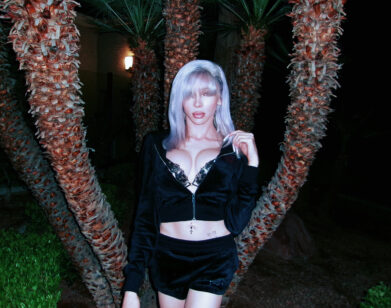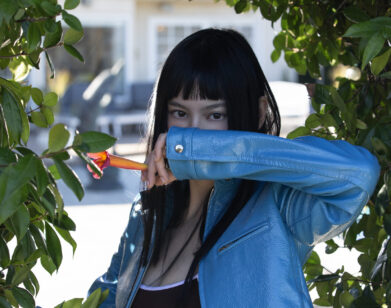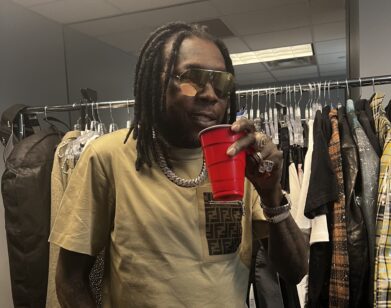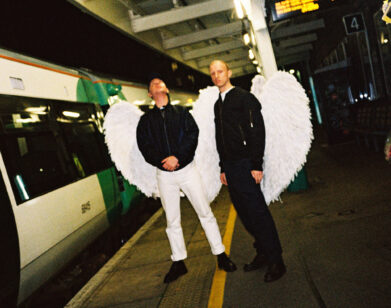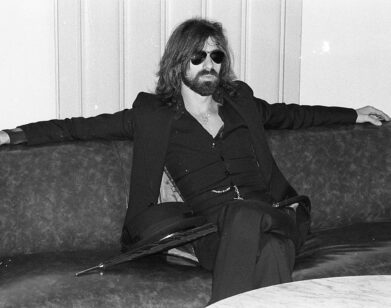Baauer and Just Blaze Get High
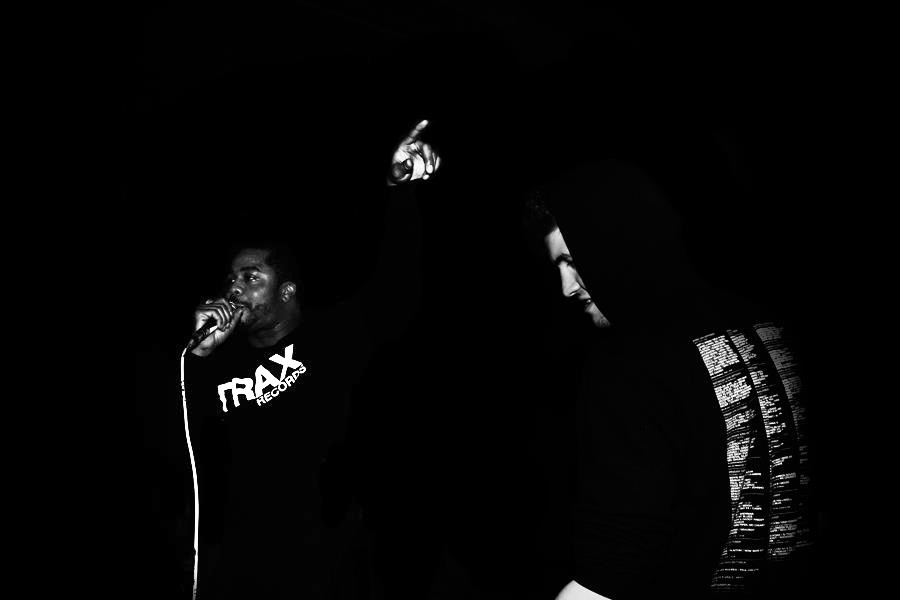
ABOVE: JUST BLAZE (LEFT) AND BAAUER. IMAGE COURTESY OF BRENT MICHAEL AZER
Just Blaze, the producer behind some of hip-hop’s biggest and most universal crossover hits—like T.I.’s “Live Your Life,” Jay-Z’s “Girls, Girls, Girls,” Kanye West’s “Touch the Sky,” and what seems like a million others—needs no introduction. The rap icon is now nearly 15 years into his career, and in an effort to reinvent himself while channeling his roots as a dance-music DJ, he’s decided to put out a new record and set out on a collaborative tour with Baauer.
You might not think you know who Baauer is, but chances are you’ve seen a dozen or so videos of people in offices (and people in the Norwegian army, and members of the Dallas Mavericks) dancing to his song, “Harlem Shake.” The guy behind that viral phenomenon is Baauer, a 23-year-old Brooklyn transplant and trap producer named Harry Rodrigues. If you haven’t seen the videos—each of which has already racked up hundreds of thousands of views just this week—do yourself a favor and set aside a few hours to check them out.
In the midst of their tour, Blaze and Baauer took a few minutes to talk to Interview about how their collaboration came about, why it doesn’t really matter if trap music is here to stay, and why being compared to PSY isn’t such a bad thing.
DAN BUYANOVSKY: You’re at about the halfway point of the tour. How’s it been going so far?
JUST BLAZE: It’s been awesome. I knew we’d get a response, but at some of these places the energy has been though the roof. In Denver they had to shut us down early because people were just going too nuts.
BUYANOVSKY: Really?
BLAZE: Yeah, the venue was oversold. They cut me off four songs into my set, and made me let them chill for like 20 minutes, then let me back on to finish my set, then they cut Harry off after 30 minutes.
BAAUER: That was messed up.
BUYANOVSKY: Wow… So you’re doing individual sets and switching off?
BAAUER: Yeah, we do like a separate set each, then we do back-to-back for the last half hour, or pretty much until they shut off all the lights and kick everybody out.
BLAZE: Until the club tells us everyone has to go home.
BAAUER: [laughs] So what do you think the crowd expects when they go to one of these shows?
BLAZE: I didn’t really think about it like that. My attitude is more like, let’s go and do what we do best. And you know, between me and Harry, you’re obviously going to get a little bit of a mix of everything, from hip-hop to classics, old stuff, new stuff, dance music, whatever. I think the main thing to expect is high energy.
BAAUER: It’s been a really cool mix, like not just raver kids, not just hip-hop kids. It’s a really unique mix.
BLAZE: And you can go across the board and everyone is having a good time. Even though there are different types of people there, they all love that energy and that music.
BUYANOVSKY: After putting out a single, you guys could have just gone your separate ways. Why did you decide to go on a tour together?
BLAZE: We have a mutual friend, and me and him were talking about possible things to do, and he mentioned Harry and me, so immediately I was just like, let’s hang out and see what the vibe is like. And we got along really well. But the thing about it is, you can have two great artists come together, and even if it looks good on paper, that doesn’t mean it’s going to work well in the studio. So initially there were just talks about doing a show, then interest grew and there was a possibility of doing a tour, then people started booking it. And I felt like—I have an audience, you have an audience, but we don’t have an audience collectively, so let’s collaborate on something. Then there were talks of a mix, and we were just like, “Screw it, we’re gonna do a record.” A month later, here we are.
BUYANOVSKY: Just, did you have any hesitation about touring with someone who’s so much younger and less experienced than you?
BLAZE: No, because for me it’s like, I haven’t toured for so long, and I know that just like there are things he could learn from me, there are definitely things I can learn from him. Even though we have a lot of things in common musically, we’re from two different points in history, so it’s a mutual learning thing. It’s always good to have younger energy around you, and it’s always good to have experienced, older energy around you, and when you put those two things together, it just makes it easy.
BUYANOVSKY: “Higher” is kind of a rework of “You Don’t Know,” which you originally produced more than 10 years ago. Had you always wanted to revisit that song?
BLAZE: Well, it’s interesting. The first version of that record, which was on the first Blueprint, I always loved but I never felt like the beat was really finished because we’d rushed it. So we re-did it on the Blueprint 2, with M.O.P., and I finally got it to that energy I wanted to get it to. Then I tried to revisit it a third time—there’s a song on Kingdom Come called “Oh My God,” and the original hook on that song went, “Turn my music higher.” We liked the idea, but then he [Jay-Z] had the idea to change it to “Oh, my God, Hov,” so we scrapped it. But the idea of revisiting it has always been in the back of my head in one way or another. So when me and Baauer got together in the studio and started putting the track together, it just hit me. The tempo was perfect, so we threw it in there, and it was perfect. It just clicked.
BUYANOVSKY: That’s crazy. So you’ve been thinking about this for a while.
BLAZE: Yeah, definitely. In terms of the concept, of just a big arena-shaking record with that hook, I’ve always known it would work.
BUYANOVSKY: Baauer, how significant is it to you to have a Jay drop at the beginning of a record you were a part of?
BAAUER: It’s, I mean, like—it’s the ultimate cosign. It’s perfect. And just to have him at the beginning of the track, it’s an amazing intro because you’re just like, “Wait, is that Jay-Z saying ‘Baauer and Just Blaze’?” It’s amazing.
BUYANOVSKY: I’ve talked to people recently who feel like trap will have the same trajectory as dubstep, and that the backlash will eventually have a negative effect on rap. How are you guys feeling about trap right now?
BLAZE: For me, here’s the thing—this is nothing new. I’ve been spinning dance music since 1990, and genres always come and go. I think as technology becomes more accessible and it’s easier for people to make music, they come and go quicker now, but it just comes with the territory. You come up with something new, something hot, and it rocks for a year. It’s nothing different from any other genre of music. I mean, name one genre that’s sounded the same for its entire existence. It doesn’t happen. So when people voice those kinds of opinions, it’s like, “Yeah, duh.”
BAAUER: I couldn’t agree more. Genres come and go, and I love the idea of not worrying about genres and just making stuff that sounds fresh and cool.
BUYANOVSKY: Just, a few years ago you were producing for Saigon and Jay Electronica, then you started to align yourself with Fool’s Gold and started to DJ more—what happened? Did you get sick of producing rap?
BLAZE: No, not at all. DJing has always been a huge part of who I am, and I got to a point where I was just able to explore those options without it affecting me financially. It used to be—sit in the studio all day, make as many beats as you can, write as many hooks as you can, and just try to sell them. But records don’t really sell like that anymore, so you have to find other ways to take your brand and apply it to what you do. I had actually stopped DJing for about five years, but I did a tour in Japan in ’03, and I just got the bug back. For me, it wasn’t so much that I got tired of rap, it was just that I had the time to do all of the things I wanted to do. Also, on a sidebar, I realized that I could stop working harder, and start working smarter. You know, to be more conscious of what you work on, and align yourself with the right things. So it’s like, slow down a bit, then produce T.I.’s “Life Your Life,” which was his biggest record, ever. Then step back again and come back and work with Jay Electronica. Then take a step back and come back and produce a third of Eminem’s Recovery. Align yourself with the right things instead of trying to do everything.
BUYANOVSKY: Baauer, I want to talk to you about “Harlem Shake.” A friend told me about it a few days ago, and then today I watched like 25 videos of people Harlem Shaking to your song. I’m sure you didn’t expect this to happen.
BAAUER: It’s definitely a total shock, but I see it as a very positive thing now. But to me, it came out of nowhere, so to see all the things they’re doing… like to see the Dallas Mavericks doing one, it’s just blowing my mind. I keep having my mind blown. But it’s funny to see that song used that way, by so many people.
BLAZE: What’s really dope about it also, is that the record isn’t really new, at this point. But out of nowhere it resurfaced, and became a hit.
BAAUER: Yeah, totally at a random time. It came out at like the end of summer, and now it’s like back again, nine months later.
BUYANOVSKY: I saw the Norwegian Army made a “Harlem Shake” video.
BAAUER: [laughs] That’s crazy.
BUYANOVSKY: One website compares you to the “Gangnam Style” guy. How do you feel about that?
BAAUER: Um… you know, I think that guy is doing pretty good right now, so I’m not too upset about that.
BUYANOVSKY: Of these three collaborations, which would you consider yourselves closest to—Willy Nelson and Snoop, Nelly and Tim McGraw, or Celine Dion and R. Kelly?
BLAZE: [laughs] Oh, my God.
BAAUER: Celine Dion and R. Kelly. [laughs]
BLAZE: I’ll buy that for a dollar.
JUST BLAZE AND BAAUER’S BIG LEAGUE TOUR STOPS AT WEBSTER HALL THIS FRIDAY, FEBRUARY 15. FOR TICKETS, CLICK HERE.

